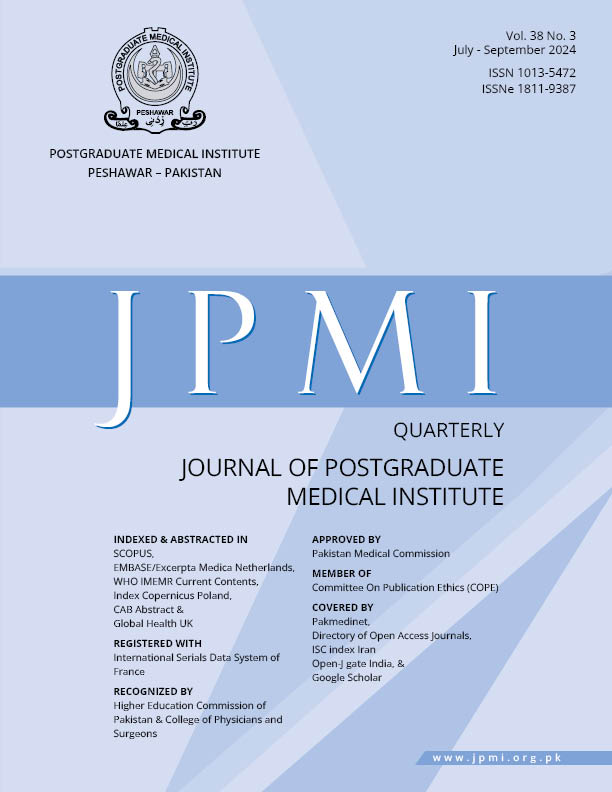Age-Related Gradual Decline in Red blood Cells Indices in Males without Hematological Disorders
Main Article Content
Abstract
Background: Somatic damage causes the aging process, which raises the chance of mortality. Evaluation of hemoglobin levels in the elderly is a challenging undertaking since it is difficult to determine whether it is decreased due to an underlying disease or simply an effect of advancing age. The study described here was designed to look at how ageing affected peripheral blood parameters in people who had no known hematological disorder.
Methods: Data from 88 participants in the age range between 18 and 92 Years with no known hematological disorder were evaluated with particular consideration for hemoglobin, red blood cells count, hematocrit, mean corpuscular volume, mean corpuscular hemoglobin, and mean corpuscular hemoglobin concentration. Four age categories were used to segment the individuals. Group I from 18 to 37 years, group II from 38 to 57 years group III from 58 to 77 years, group IV is 78years onwards.
Results: Hemoglobin, red blood cells count, hematocrit, mean corpuscular volume, mean corpuscular hemoglobin, and mean corpuscular hemoglobin concentration in the serum were analyzed. There was a highly significant (p<0.05) difference between hemoglobin, hematocrit and mean corpuscular hemoglobin concentration, among the four groups on comparison with a one-way ANOVA test. These results strongly support the hypothesis that there is a progressive decrease in RBC parameters with advancing age even in the absence of any known illness.
Conclusions: RBC parameters varied with increasing age and differed between young males as compared to old age, indicating a decline in erythropoiesis in elderly males.
Article Details
Work published in JPMI is licensed under a
Creative Commons Attribution-NonCommercial 2.0 Generic License.
Authors are permitted and encouraged to post their work online (e.g., in institutional repositories or on their website) prior to and during the submission process, as it can lead to productive exchanges, as well as earlier and greater citation of published work.
References
Bruserud Ø, Vo AK, Rekvam H. Hematopoiesis, Inflammation and Aging-The Biological Background and Clinical Impact of Anemia and Increased C-Reactive Protein Levels on Elderly Individuals. Journal of clinical medicine. 2022;11(3).
Stucker S, Chen J, Watt FE, Kusumbe AP. Bone Angiogenesis and Vascular Niche Remodeling in Stress, Aging, and Diseases. Frontiers in cell and developmental biology. 2020;8:602269.
de Haan G, Lazare SSJB, The Journal of the American Society of Hematology. Aging of hematopoietic stem cells. 2018;131(5):479-87.
Girelli D, Marchi G, Camaschella C. Anemia in the Elderly. HemaSphere. 2018;2(3):e40.
Wacka E, Wawrzyniak-Gramacka E, Tylutka A, Morawin B, Gutowicz M, Zembron-Lacny A. The Role of Inflammation in Age-Associated Changes in Red Blood System. International journal of molecular sciences. 2023;24(10).
Kant S, Kumar R, Malhotra S, Kaur R, Haldar P. Prevalence and Determinants of Anemia among Adult Males in a Rural Area of Haryana, India. Journal of epidemiology and global health. 2019;9(2):128-34.
Steinmeyer Z, Delpierre C, Soriano G, Steinmeyer A, Ysebaert L, Balardy L, et al. Hemoglobin concentration; a pathway to frailty. BMC geriatrics. 2020;20(1):202.
Ma S, Wang S, Qi X, Han K, Jin X, Li Z, et al. Multiscale computational framework for predicting viscoelasticity of red blood cells in aging and mechanical fatigue. 2022;391:114535.
Lee JY, Choi H, Park JW, Son BR, Park JH, Jang LC, et al. Age-related changes in mean corpuscular volumes in patients without anaemia: An analysis of large-volume data from a single institute. Journal of cellular and molecular medicine. 2022;26(12):3548-56.
Karoopongse E, Srinonprasert V, Chalermsri C, Aekplakorn W. Prevalence of anemia and association with mortality in community-dwelling elderly in Thailand. Scientific reports. 2022;12(1):7084.
Turner J, Parsi M, Badireddy M. Anemia. StatPearls [Internet]: StatPearls Publishing; 2022.
Shaheen NA, Rehan H, Moghairi A, Gmati G, Damlaj M, Salama H, et al. Hematological indices in the adult Saudi population: Reference intervals by gender, age, and region. 2022;9:901937.
Anggraini D, editor Characteristics of Anemia in Elderly Patients at Siti Rahmah Hospital, Padang, Indonesia. 1st International Conference on Health Sciences and Biotechnology (ICHB 2021); 2022: Atlantis Press.
Hanif W, Iqbal H, Gul S, Qureshi MA, Shujat U, Anwar NJPJoP. MORPHOLOGICAL TYPES OF ANEMIA AND ITS ASSOCIATION IN GERIATRIC POPULATION. 2023;34(2):47-50.
Hassan JM, Rehman M, Imteyaz PS, Khan S, Ahmad N, Jetley SJJS. A clinical and hematological profile in geriatric patients with special emphasis on morphological and etiological classification of anemia in these patients-a pilot study. 2020;22(4):187-92.
Fletcher A, Forbes A, Svenson N, Wayne Thomas D, Haematology ABSfHGPPJBJo. Guideline for the laboratory diagnosis of iron deficiency in adults (excluding pregnancy) and children. 2022;196(3):523-9.
Elstrott B, Khan L, Olson S, Raghunathan V, DeLoughery T, Shatzel JJJEjoh. The role of iron repletion in adult iron deficiency anemia and other diseases. 2020;104(3):153-61.
Alsaeed M, Ahmed SS, Seyadi K, Ahmed AJ, Alawi AS, Abulsaad K. The prevalence and impact of anemia in hospitalized older adults: A single center experience from Bahrain. Journal of Taibah University Medical Sciences. 2022;17(4):587-95.
Debnath A, Rehman T, Ghosh T, Kaur A, Ahamed F. Prevalence of Anemia Among Elderly Population Residing in an Urban Area of West Bengal: A Community-Based Cross-Sectional Analytical Study. Indian journal of community medicine : official publication of Indian Association of Preventive & Social Medicine. 2022;47(4):604-8.
Chaparro CM, Suchdev PS. Anemia epidemiology, pathophysiology, and etiology in low- and middle-income countries. Annals of the New York Academy of Sciences. 2019;1450(1):15-31.
Arkew M, Asmerom H, Tesfa T, Tsegaye S, Gemechu K, Bete T, et al. Red blood cell parameters and their correlation with glycemic control among type 2 diabetic adult patients in Eastern Ethiopia: a comparative cross-sectional study. 2022:3499-507.
Winchester LM, Powell J, Lovestone S, Nevado-Holgado AJJGm. Red blood cell indices and anaemia as causative factors for cognitive function deficits and for Alzheimer’s disease. 2018;10(1):1-12.
Haas JD, Brownlie IV TJTJon. Iron deficiency and reduced work capacity: a critical review of the research to determine a causal relationship. 2001;131(2):676S-90S.


